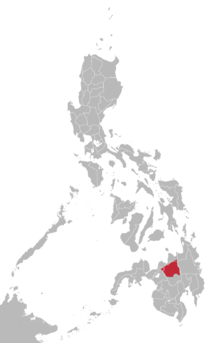Bukid language
| Bukid | |
|---|---|
| Binukid | |
| Native to | Philippines |
| Region | most parts of Bukidnon province, Mindanao |
Native speakers | (100,000 cited 1987)[1] |
| Dialects |
|
| Language codes | |
| ISO 639-3 |
bkd |
| Glottolog |
binu1244[2] |
 Area where Binukid is spoken[1] | |
The Bukid language, Binukid or Bukidnon, is an Austronesian language spoken by indigenous peoples of Northern Mindanao in southern Philippines. The word Bukid means "mountain" or “highland” while Binukid means "in the manner, or style, of the mountain or highland". It is a de facto co-official language in Bukidnon province, where it is referred to as Higaonon. There are many dialects but there is mutual intelligibility. The dialect of Malaybalay, in the Pulangi area, is considered to be the prestige and standard variety.[3].
Distribution
Binukid is spoken in the following areas (Ethnologue).
- central and northern Bukidnon Province
- northeastern Lanao del Norte Province
- Misamis Oriental Province: Cagayan de Oro area including southwest of Gingoog Bay
- very small border strip of Lanao del Sur
Phonology
Binukid consists[4] of 20 segmental phonemes and 1 suprasegmental phoneme. The syllable is the basic unit of word structure, and each syllable consists of one vowel and one or two consonants only, arranged in the following patterns: CV, CVC and, in some instances, CCV (which is found mostly in Spanish loanwords). A word consists of one or more of these syllables.
Consonants
There are 16 consonants in Binukid. In some instances, there is a voiceless alveolo-palatal affricate ⟨t͡ɕ⟩ which appears in Spanish loanwords.
| Bilabial | Alveolar | Velar | Palatal | Glottal | |
|---|---|---|---|---|---|
| voiceless stop | p | t | k | ʔ | |
| voiced stop | b | d | ɡ | ||
| fricative | s | h | |||
| nasal | m | n | ŋ | ||
| lateral | l | ||||
| tap | ɾ | ||||
| semivowel | w | j |
The phoneme [ɾ] is sometimes trilled which is used in intervocalic position or in Spanish loanwords by some speakers. All consonants except [h] are found in initial and final position in the syllable; [h] is found only syllable-initial.
Vowels
There are generally four vowels in Binukid[4].
| Front (unrounded) | Central (unrounded) | Back (rounded) | |
|---|---|---|---|
| Close | i | u | |
| Close-mid | ɘ | ||
| Open | ä |
Suprasegmentals
There is a suprasegmental phoneme of stress which usually falls on the penultimate syllable. Stress give contrast to words of the same segmental phonemes; for example beleng [ˈbɘlɘŋ] means "surprise" while beléng [bɘˈlɘŋ] means "drunk". Long words may have more than one stress: balángkawítan [bäˌläŋkaˈwitän] "rooster". Stress commonly shift when suffixes are added to the word (as in kahibeléngan "mysterious") or when the speaker wishes to emphasize the word.
Writing System and Orthography
Binukid uses the Latin script, particularly the Filipino abakada, and seldom Baybayín in writing the language. The Binukid alphabet[3] consists of the following letters which correspond to one phoneme. Word-initial and word-final glottal stops are not written but glottal stops following a consonant is marked by a hyphen. Example: hab-ung [ˈhäbʔuŋ] "mildew". The phoneme [ŋ] is represented by a digraph ⟨ng⟩, which is sometimes considered as a separate letter.
| Letter | Aa | Bb | Kk | Dd | Ee | Gg | Hh | Ii | Ll | Mm | Nn | Pp | Rr | Ss | Tt | Uu | Ww | Yy |
|---|---|---|---|---|---|---|---|---|---|---|---|---|---|---|---|---|---|---|
| Phoneme | ä | b | k | d | ɘ | g | h | i | l | m | n | p | ɾ | s | t | u | w | j |
Suprasegmental phonemes and glottalization are featured in writing Binukid[3][5]. Stress is indicated by an acute accent ⟨′⟩. A grave accent ⟨`⟩ is marked over syllable- or word-final vowel to indicate a following glottal stop. If stress is shown on the final letter and there is a following glottal stop, a circumfex accent ⟨ˆ⟩ is used. There is no marking for words whose stress falls on the penultimate syllable and without a secondary stress.
Examples:
- sala [ˈsälä] "living room"
- salà [ˈsäläʔ] "small cut"
- salâ [säˈläʔ] "sin"
- pahid [ˈpähid] "to wipe"
- pahíd [päˈhid] "shrub"
- balángkawítan [bäˌläŋkaˈwitän] "rooster"
- talètè [täˈlɘʔtɘʔ] "lizard"
Spelling Modification
Other letters are introduced through proper names, for example:
- California instead of Kalipúrniya
- Juan Carlos instead of Huwán Karlus
The plural particle marker manga is written mga, following accepted Philippine usage.
References
- 1 2 Bukid at Ethnologue (18th ed., 2015)
- ↑ Hammarström, Harald; Forkel, Robert; Haspelmath, Martin, eds. (2017). "Binukid". Glottolog 3.0. Jena, Germany: Max Planck Institute for the Science of Human History.
- 1 2 3 Post, Ursula (1978). Binukid Dictionary. Philippines: Summer Institute of Linguistics. pp. 14–15.
- 1 2 Atherton, William (1953). "Binokid Phonemes". Summer Institute of Linguistics: 101–104 – via SIL.
- ↑ Peng, Adam (2008). "Binukid Pronominal Clisis". Studies in Philippine languages and cultures. 17: 179–212.
External links